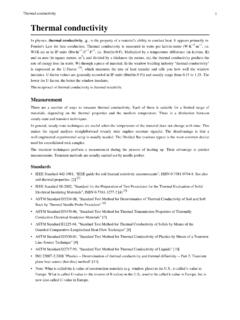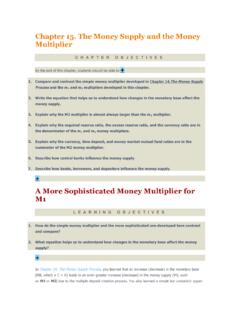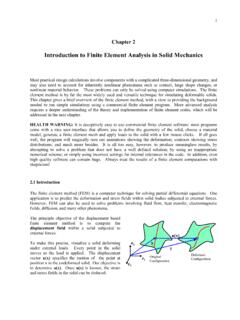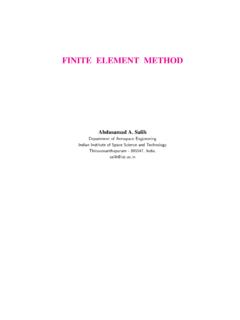Transcription of Sorting algorithm - Saylor Academy
1 Sorting algorithm1 Sorting algorithmIn computer science, a Sorting algorithm is an algorithm that puts elements of a list in a certain order. Themost-used orders are numerical order and lexicographical order. Efficient Sorting is important for optimizing the useof other algorithms (such as search and merge algorithms) that require sorted lists to work correctly; it is also oftenuseful for canonicalizing data and for producing human-readable output. More formally, the output must satisfy output is in nondecreasing order (each element is no smaller than the previous element according to thedesired total order); output is a permutation, or reordering, of the the dawn of computing, the Sorting problem has attracted a great deal of research, perhaps due to thecomplexity of solving it efficiently despite its simple, familiar statement.
2 For example, bubble sort was analyzed asearly as 1956.[1] Although many consider it a solved problem, useful new Sorting algorithms are still being invented(for example, library sort was first published in 2004). Sorting algorithms are prevalent in introductory computerscience classes, where the abundance of algorithms for the problem provides a gentle introduction to a variety ofcore algorithm concepts, such as big O notation, divide and conquer algorithms, data structures, randomizedalgorithms, best, worst and average case analysis, time-space tradeoffs, and lower algorithms used in computer science are often classified by: Computational complexity (worst, average and best behaviour) of element comparisons in terms of the size of thelist.
3 For typical Sorting algorithms good behavior is and bad behavior is . (See BigO notation.) Ideal behavior for a sort is , but this is not possible in the average case. Comparison-basedsorting algorithms, which evaluate the elements of the list via an abstract key comparison operation, need at leastcomparisons for most inputs. Computational complexity of swaps (for "in place" algorithms). Memory usage (and use of other computer resources). In particular, some Sorting algorithms are "in place". Thismeans that they need only or memory beyond the items being sorted and they don't need tocreate auxiliary locations for data to be temporarily stored, as in other Sorting algorithms.
4 Recursion. Some algorithms are either recursive or non-recursive, while others may be both ( , merge sort). Stability: stable Sorting algorithms maintain the relative order of records with equal keys ( , values). Seebelow for more information. Whether or not they are a comparison sort. A comparison sort examines the data only by comparing two elementswith a comparison operator. general method: insertion, exchange, selection, merging, Exchange sorts include bubble sort and sorts include shaker sort and heapsort. Adaptability: Whether or not the presortedness of the input affects the running time.
5 Algorithms that take this intoaccount are known to be Sorting algorithms maintain the relative order of records with equal keys. If all keys are different then thisdistinction is not necessary. But if there are equal keys, then a Sorting algorithm is stable if whenever there are tworecords (let's say R and S) with the same key, and R appears before S in the original list, then R will always appearbefore S in the sorted list. When equal elements are indistinguishable, such as with integers, or more generally, anydata where the entire element is the key, stability is not an issue.
6 However, assume that the following pairs ofSorting algorithm2numbers are to be sorted by their first component:(4, 2) (3, 7) (3, 1) (5, 6)In this case, two different results are possible, one which maintains the relative order of records with equal keys, andone which does not:(3, 7) (3, 1) (4, 2) (5, 6) (order maintained)(3, 1) (3, 7) (4, 2) (5, 6) (order changed)Unstable Sorting algorithms may change the relative order of records with equal keys, but stable Sorting algorithmsnever do so. Unstable Sorting algorithms can be specially implemented to be stable.
7 One way of doing this is toartificially extend the key comparison, so that comparisons between two objects with otherwise equal keys aredecided using the order of the entries in the original data order as a tie-breaker. Remembering this order, however,often involves an additional computational based on a primary, secondary, tertiary, etc. sort key can be done by any Sorting method, taking all sort keysinto account in comparisons (in other words, using a single composite sort key). If a Sorting method is stable, it isalso possible to sort multiple times, each time with one sort key.
8 In that case the keys need to be applied in order ofincreasing : Sorting pairs of numbers as above by second, then first component:(4, 2) (3, 7) (3, 1) (5, 6) (original)(3, 1) (4, 2) (5, 6) (3, 7) (after Sorting by second component)(3, 1) (3, 7) (4, 2) (5, 6) (after Sorting by first component)On the other hand:(3, 7) (3, 1) (4, 2) (5, 6) (after Sorting by first component)(3, 1) (4, 2) (5, 6) (3, 7) (after Sorting by second component, order by first component is disrupted). Sorting algorithm3 Comparison of algorithmsThe complexity of different algorithms in aspecific this table, n is the number of records to be sorted.
9 The columns"Average" and "Worst" give the time complexity in each case, underthe assumption that the length of each key is constant, and thattherefore all comparisons, swaps, and other needed operations canproceed in constant time. "Memory" denotes the amount of auxiliarystorage needed beyond that used by the list itself, under the sameassumption. These are all comparison sorts. The run time and thememory of algorithms could be measured using various notations liketheta, sigma, Big-O, small-o, etc. The memory and the run times beloware applicable for all the 5 sortsName Best Average WorstMemory Stable MethodOther notes Spaghetti(Poll) sortYesPollingThis A linear-time, analog algorithm forsorting a sequence of items, requiring O(n)stack space, and the sort is stable.
10 Thisrequires a parallel processor. Spaghettisort#AnalysisQuicksortDependsPa rtitioningQuicksort can be done in place withO(log(n)) stack space, but the sort is ve variants use an O(n) space array tostore the partition. An O(n) spaceimplementation can be sortDependsYesMergingUsed to sort this table in Firefox [2].HeapsortNoSelectionInsertion sortYesInsertionAverage case is also , where d isthe number of inversionsIntrosort NoPartitioning& SelectionUsed in SGI STL implementationsSelectionsortNoSelectionI ts stability depends on the to sort this table in Safari or otherWebkit web browser [3].
















